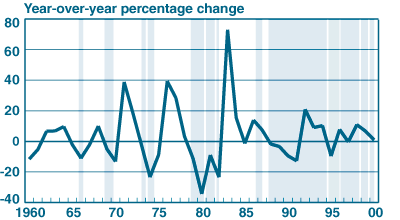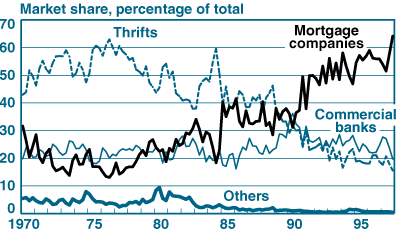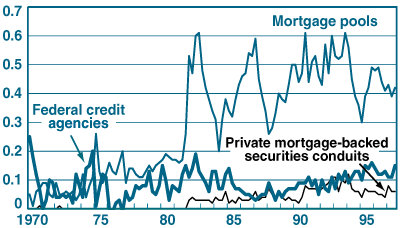| Recapping an article from the May 2002 issue |
|
| of the Economic Policy Review, Volume 8, Number 1 | View full article |
|
|
|
20 pages / 225 kb | |
|
Authors: Jonathan McCarthy and Richard W. Peach |
Disclaimer | |
| Index of executive summaries |
|
Overview The authors examine how the transmission of monetary policy to residential investment has changed since the mid-1980s. They find that the ultimate magnitude of residential investment's response to a monetary policy "shock" is more or less the same in 1986-2000 as it was in 1975-85. However, the response does not occur as quickly today as it did in the past; the timing of the response is now similar to the timing of the overall economy's response to a policy action. Today, a monetary policy shock affects residential investment solely through the price of mortgage credit, whereas in the past, its effect was felt largely through nonprice forms of mortgage credit rationing. Background The volatility of residential investment in single-family structures has declined considerably since the mid-1980s, in conjunction with a fundamental restructuring of the nation's housing finance system (chart). The system is essentially three interrelated but distinct markets: the primary mortgage market, the secondary mortgage market, and the market for mortgage-backed securities. Over the past thirty years, the underlying institutional setting of those markets has changed dramatically in response to macroeconomic conditions, deregulation, and financial and technological innovations. Before the mid-1980s, the housing finance system was heavily regulated and dominated by thrift institutions; it has since shifted to a relatively unregulated system centered on mortgage companies (chart) and mortgage securitization (chart). As a result of these changes, the housing markets have become more fully integrated with the broader capital markets. The supply of mortgage credit is therefore no longer subject to sharp fluctuations in inflows and outflows of deposits at thrift institutions. Argument and Methodology The authors reason that the transmission of monetary policy to residential investment may have changed with the restructuring of the housing finance system. The decline in the volatility of mortgage credit, along with greater competitiveness in the mortgage markets prompted by deregulation, suggests that a policy action is now likely to have a different effect on nonprice rationing of mortgage credit than it did before the mid-1980s. Accordingly, the authors examine whether the changes in the housing finance system have altered the strength and/or timing of monetary policy's effect on the housing sector. Findings The study relies on a two-part analysis of the transmission of monetary policy changes to residential investment. In the first part, a macroeconomic model is used to examine the response of the housing markets to a policy shock. Because the restructuring of the housing finance system was largely completed by the mid-1980s, the authors estimate their model over 1975:1-1985:4 and 1986:1-2000:3. The effects of monetary policy in each period are measured by the market response to a 50-basis-point change in the federal funds rate. The model's results suggest that the effect on residential investment is equally strong in both periods, but it now takes longer for that effect to be realized. In the second part, the authors employ a structural model of investment in single-family housing. Their intent is to examine the effect of changes in the housing finance system on the housing markets and on the markets' response to changes in monetary policy. Here, most of the model's supply and demand pricing factors are found to have significant effects only after the mid-1980s. The evidence suggests that policy is now transmitted to housing through such pricing channels as mortgage interest rate costs and transaction costs, rather than through quantitative financing restrictions, as was typical before the mid-1980s. |
|
|
|
|
|
|
| Residential Investment: Single-Family Structures Billions of 1996 Chain-Weighted Dollars |
|
 Sources: Bureau of Economic Analysis; Board of Governors of the Federal Reserve System, Sources: Bureau of Economic Analysis; Board of Governors of the Federal Reserve System,Flow of Funds. Note: Shaded regions indicate periods of deposit outflows. |
|
|
|
|
Market Shares of Long-Term Loan Originations for Single-Family Properties  Source: Housing and Urban Development Agency, Office of Financial Management, Source: Housing and Urban Development Agency, Office of Financial Management,Survey of Mortgage Lending Activity. Note: Figures are based on quarterly averages of monthly survey data. |
|
|
|
|
Ratio of Net Acquisitions to Total Originations for Long-Term Single-Family Loans  Source: Housing and Urban Development Agency, Office of Financial Management, Source: Housing and Urban Development Agency, Office of Financial Management, Survey of Mortgage Lending Activity. Note: Figures are based on quarterly averages of monthly survey data. |
|
|
Commentary on article by Christopher Mayer |
|
| Disclaimer | |
|
The views expressed in this article are those of the authors and do not necessarily reflect the position of the Federal Reserve Bank of New York or the Federal Reserve System. |
|













